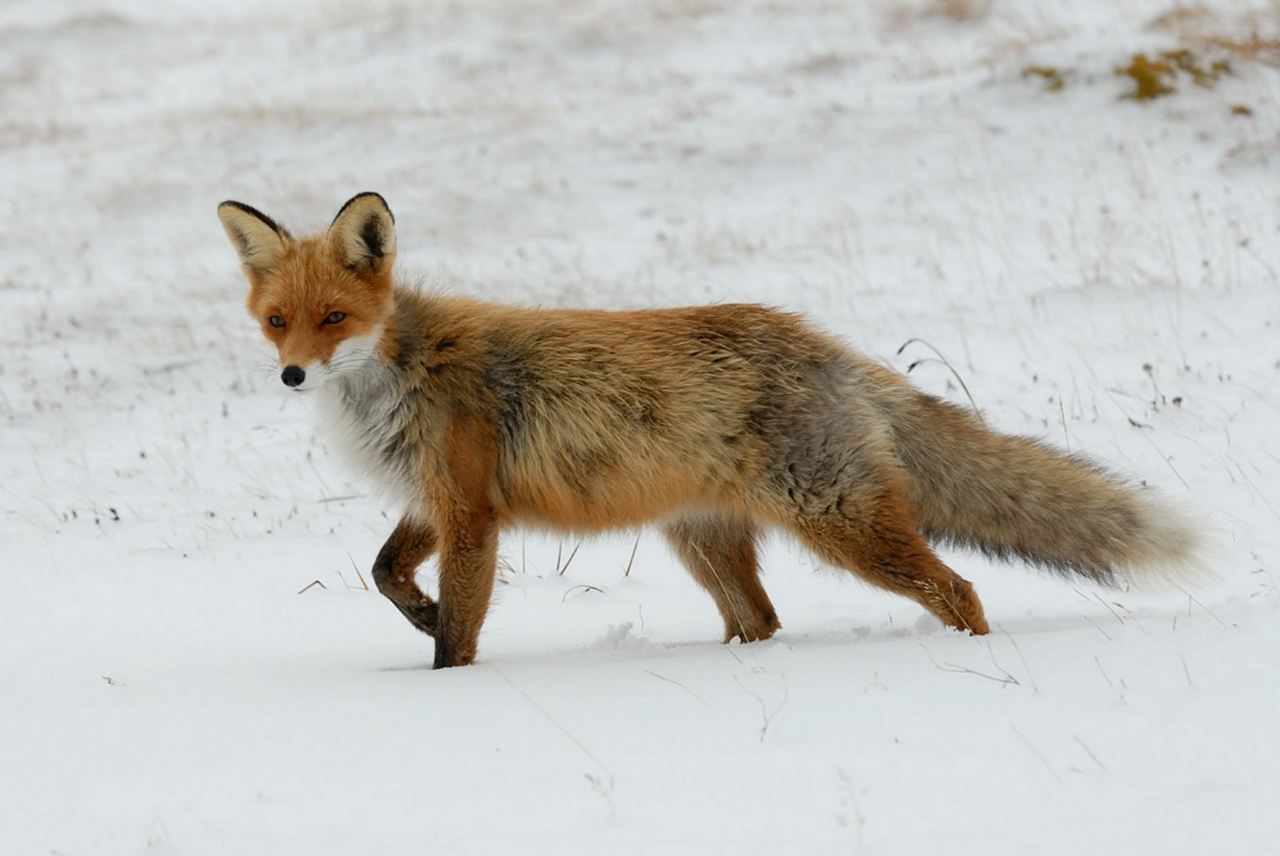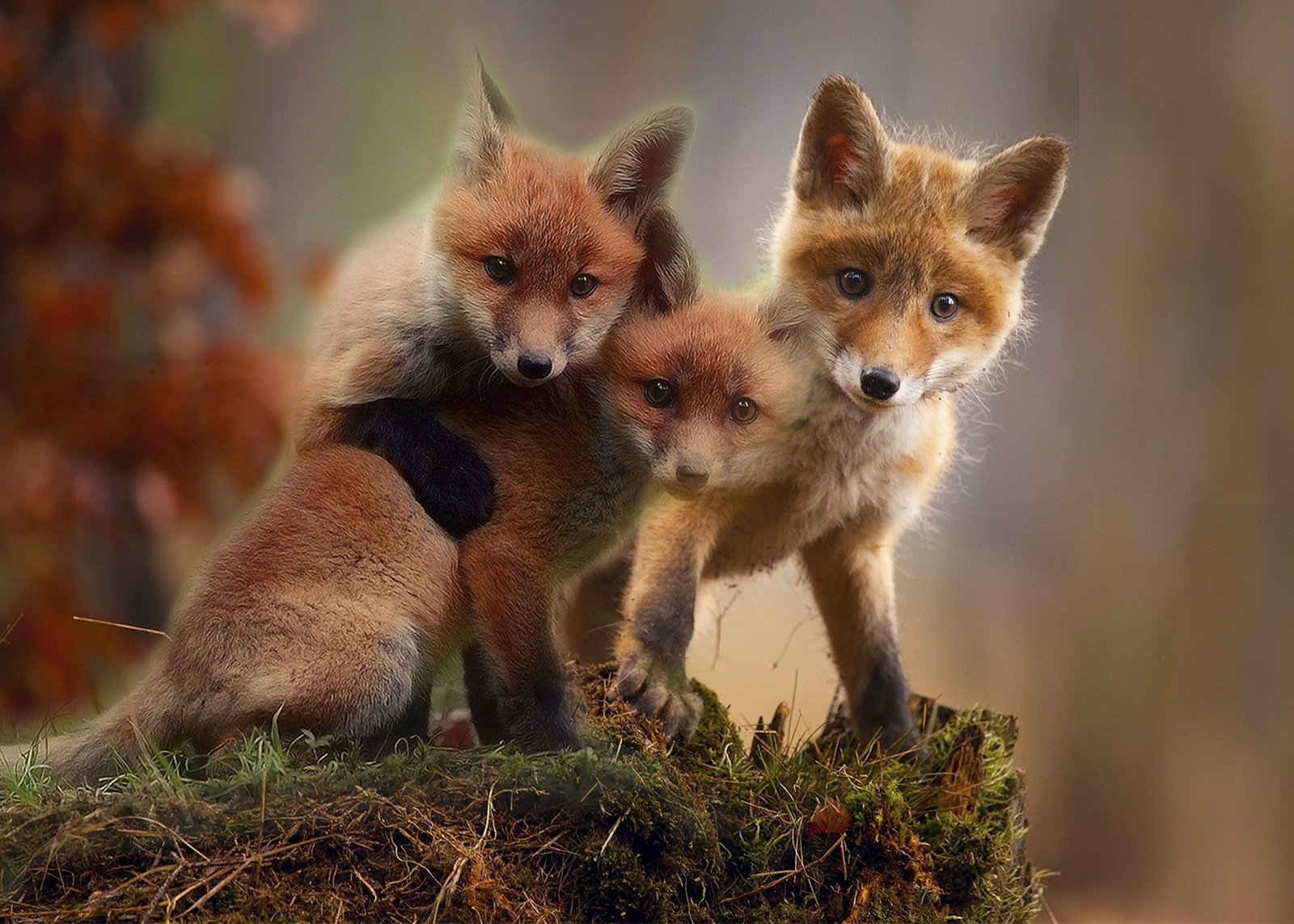Red Fox: Vulpes Vulpes

Description Of The Red Fox
Long snouts and red fur are found in red foxes across the face, back, sides, and tail. They have a greyish-white throat, chin, and stomach. Red foxes also have large and pointy black feet and black-tipped ears. Their fluffy white-tipped tail is one of the most noticeable characteristics of the red fox. Red foxes are about three feet in length and two feet in height.
Gray foxes are frequently confused with Red foxes, which share similar habitats and ranges. As some red foxes may have large patches of gray fur, and gray foxes may have patches of red fur, this can make identification difficult. Gray foxes are slightly smaller and have a shorter snout and a slightly more rounded face.
Looking for the color at the tip of the tail is the surefire way to tell which fox you are looking at. There are black-tipped tails on gray foxes, while red fox tails’ is white-tipped. Although very similar in name and appearance, these foxes are only distant cousins, belonging to different genera in the Canidae family. 1Go To Source nwf.org -“Red Fox Vulpes vulpes”
Learn More: Nuisance Fox Species
Average Red Fox Size
Size of the average adult red fox:
- Total Length: 36-42 in
- Tail Length: 14-16 in
- Height: 14-20 in
- Weight: 10-15 lbs
Red Fox Habitat
A wide range of habitats are used by red foxes, including forests, tundra, prairie, desert, mountains, farmland, and urban areas. They prefer areas of mixed vegetation, such as edge habitats and mixed scrub and woodland.
They are found from sea level to an elevation of 14760 feet. Territories may range from 3 to 7 square miles.
Range Of The Red Fox Species

In North America, except for portions of the Southwest, the extreme Southeast, and the Great Plains, the red fox occurs throughout Canada and most of the U.S. In Adirondack Park, this species occupies all terrestrial habitats, from the lowest to the highest elevations, but prefers meadows, agricultural land, forest openings, brushy fields, and forest edges and woodland. 2Go To Source esf.edu -“Red Fox (Vulpes vulpes Desmarest)”
Red Fox Behavior
Red foxes are relatively solitary animals and, like wolves, do not form packs. Depending on the quality of the habitat, individual adults have home ranges that vary in size. There may be ranges of between 5 and 12 square kilometers in good food supply areas; ranges of between 20 and 50 square kilometers in poorer habitats.
During some parts of the year, adjacent ranges may overlap somewhat, but red foxes generally defend their territories from intrusion by other foxes. The ranges occupy an adult male, one or two adult females, and their young ones.
In earthen dens, individuals and family groups live and often have other emergency burrows within the home range. Dens of other animals are frequently taken over by foxes, such as badgers or marmots. During winter and the young’s birth and rearing, larger dens may be dug and used. In several generations, the same den is often used. Pathways connect the main den with other resting sites, favored hunting grounds, and food storage areas throughout the home range.
The top running speed is about 48km/h, and barriers as high as 2 m can be climbed. In the autumn after their birth, the pups will often leave their parents’ territory to establish their own. These young may travel as little as 10 kilometers or as much as 400 kilometers to establish their own territory. For their entire life, these animals remain in the same home range. 3Go To Source biokids.umich.edu -“Red fox Vulpes vulpes”
Reproduction Of Red Foxes
Red fox mating occurs from early January to late March. Right after mating, the female will make one or more dens. If the original den is disturbed, the extra dens are used.
The female gives birth to a litter between one and ten kits, just under two months after mating. While she is looking after the kits, the male brings the female food.
When the kits are about a month old, they begin playing outside the den. The mother starts feeding regurgitated food to her kits, but she will eventually bring them live prey to “play” with and eat.
Playing with live prey helps the red fox kits develop hunting skills. When they are about seven months old, these kits leave their mother and begin their own lives. 4Go To Source nhptv.org -“Red Fox – Vulpes vulpes”
Red Fox Communication Methods

Red foxes have a broad repertoire of vocalizations that are used for a variety of purposes. A quick series of barks, and a scream-like variation on a howl, are the most commonly heard red fox vocalizations. Their bark is pitched very high and sounds like ow-wow-wow-wow-wow. It is often mistaken for the hooting of an owl. The bark sequence is believed to be an identification system, and studies indicate that this call can tell foxes apart from each other.
During the breeding season, in the springtime, the scream-like howl is most often heard. It is believed that vixens (female foxes) use this call to lure male foxes to them for mating, although males have also been found to make this sound occasionally.
Most other vocalizations of foxes are quiet and used in close proximity for communication between individuals. The most unusual is called “gekkering.” With occasional yelps and howls, it is a guttural chattering. In aggressive encounters, Gekkering is heard among adults and also among young during playtime.
They also have an alarm call, which sounds like a cough up close, but sounds like a sharp bark from afar and is used mostly by fox parents to alert the young of danger. 5Go To Source chesapeakebay.net -“Red Fox Vulpes vulpes”
Diet Of The Red Fox
Red foxes eat about a pound of meat during a meal. They often kill more than they can eat when food is abundant. The surplus is buried and marked with urine or covered with leaves or grass. They may or may not come back to eat the food. Skunks, crows, opossums, or other foxes may raid some of those food caches.
Around 60 percent of the diet of a red fox consists of rabbits and mice. The following food groups and their percentages by volume were found in a study in Missouri:
- Rabbit 33.5 %
- Rodents 23.7%
- Poultry 13.6%
- Livestock 5.4%
- Other (Birds, Plants, Etc.) 23.8% 6Go To Source illinois.gov -“Red Fox”
Red Fox Predators
The majority of red foxes caught by natural predators are young pups. To avoid this, pups are kept in and near a den and protected by their family. Coyotes, wolves, or other predators may also attack adult red foxes, but this is rarely done to eat them.
Humans are the most important predators of red foxes, who hunt foxes for their fur and kill them as pests in large numbers. 7Go To Source animaldiversity.org -“Vulpes vulpes red fox”
Disease Affecting Red Foxes

An indication of a diseased fox is aggressive behavior. Red foxes can carry various diseases (rabies is the most common), but healthy foxes pose virtually no risk to human health. Avoiding approaching and handling wild animals is the best way to prevent exposure to any wildlife diseases.
Also, pets should be kept away from wildlife and vaccinated against rabies. If you have observed a sick or injured red fox, stay away and contact wildlife removal experts of the potential threat. 8Go To Source cpw.state.co.us -“Red Foxes”
Red Fox Interaction With Humans
Foxes often live in close proximity to human homes and communities where they can find plenty of food, water, and shelter. Yards, parks, and golf courses, particularly areas adjacent to suitable, undeveloped habitats, are often inhabited by foxes.
Foxes can get used to human activity but are rarely aggressive towards individuals. Depredation on domestic animals, perceptions of risk to humans, and their potential to carry disease organisms are problems associated with foxes.
Seeing a fox doesn’t automatically mean danger, but smaller pets and livestock will be at risk. However, those who are uncomfortable with foxes’ presence can contact wildlife removal professionals to rid their property of these pests. 9Go To Source portal.ct.gov -“Red Fox Vulpes vulpes”
Sources:
- “Red Fox.” National Wildlife Federation, National Wildlife Federation, www.nwf.org/Educational-Resources/Wildlife-Guide/Mammals/Red-Fox. Accessed 1 Feb. 2021.
- Communications, Esf Office Of. “Red Fox | Adirondack Ecological Center | SUNY ESF | College of Environmental Science and Forestry.” ESF SUNY College of Environmental Science Forestry, State University of New York, www.esf.edu/aec/adks/mammals/red_fox.htm. Accessed 1 Feb. 2021.
- Fox, D. 2007. “Vulpes vulpes” (On-line), Animal Diversity Web. Accessed February 01, 2021 at http://www.biokids.umich.edu/accounts/Vulpes_vulpes/
- “Red Fox – Vulpes Vulpes – NatureWorks.” Nature Works, New Hampshire PBS, www.nhptv.org/natureworks/redfox.htm. Accessed 1 Feb. 2021.
- “Red Fox | Chesapeake Bay Program.” Chesapeake Bay Program, Chesapeake Bay Program, www.chesapeakebay.net/S=0/fieldguide/critter/red_fox. Accessed 1 Feb. 2021.
- “Red Fox – Wildlife.” Illinois Department of Natural Resources, IL DNR, www2.illinois.gov/dnr/conservation/wildlife/Pages/Red-Fox.aspx. Accessed 1 Feb. 2021.
- Fox, D. 2007. “Vulpes vulpes” (On-line), Animal Diversity Web. Accessed February 01, 2021 at https://animaldiversity.org/accounts/Vulpes_vulpes/
- “Red Foxes.” Colorado Parks & Wildlife, cpw.state.co.us/fox. Accessed 1 Feb. 2021.
- “—.” CT.Gov – Connecticut’s Official State Website, portal.ct.gov/DEEP/Wildlife/Fact-Sheets/Red-Fox. Accessed 1 Feb. 2021.
